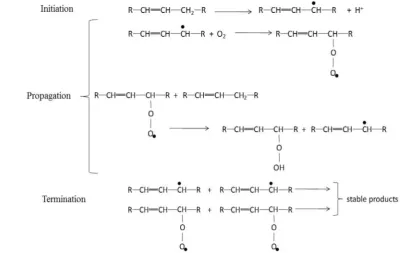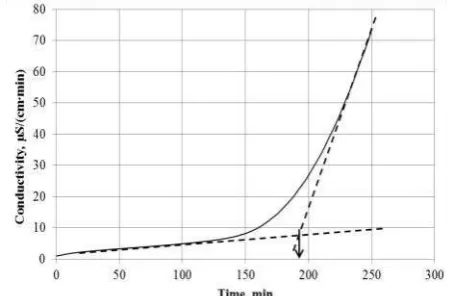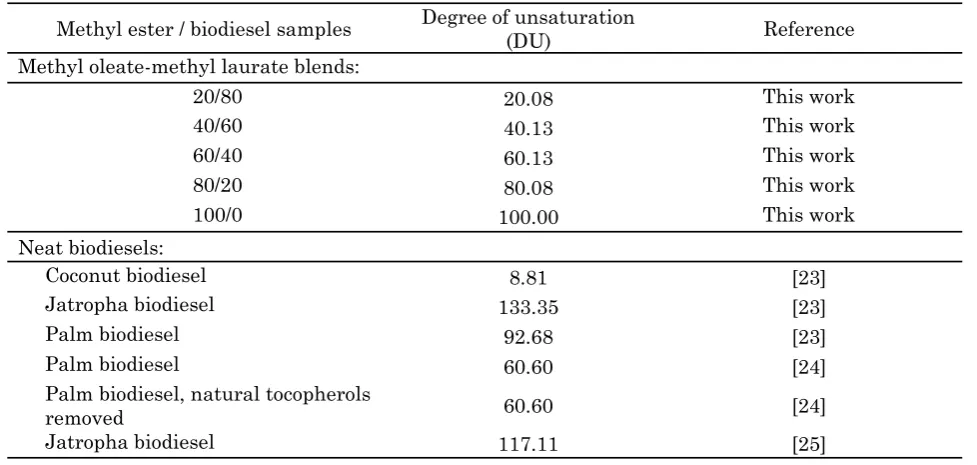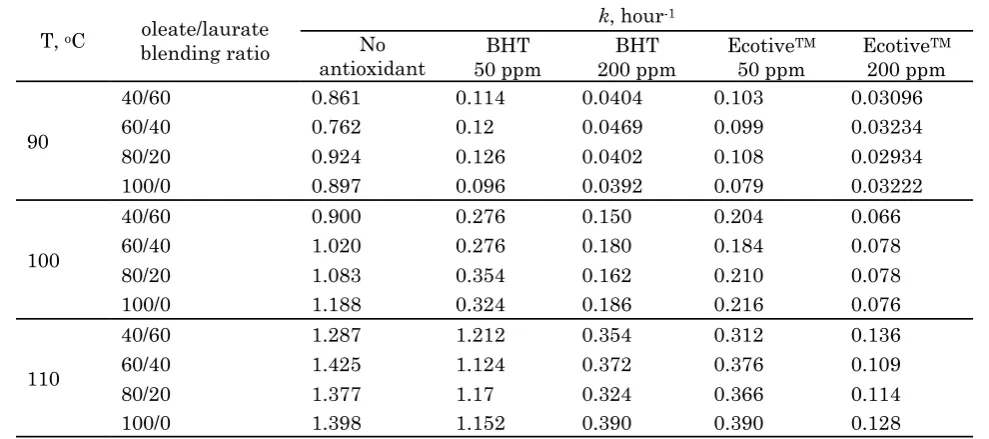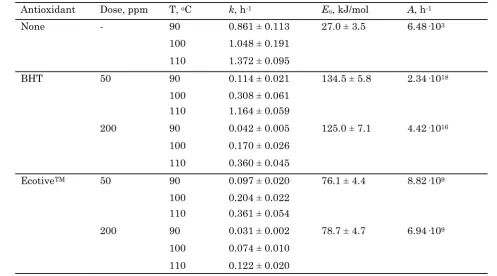Measurement of Antioxidant Effects on the
Auto-oxidation Kinetics of Methyl Oleate-Methyl Laurate
Blend as a Surrogate Biodiesel System
Tjokorde Walmiki Samadhi1*, Toshihiro Hirotsu2, Shinichi Goto2
1Chemical Engineering Program, Faculty of Industrial Technology, Bandung Institute of Technology, Jln. Ganesha 10, Bandung 40132, Indonesia
2Research Center for New Fuels and Vehicle Technology, National Institute of Advanced Industrial Science and Technology, AIST Tsukuba East, 1-2-1 Namiki, Tsukuba, Ibaraki 8564, Japan
Bulletin of Chemical Reaction Engineering & Catalysis, 12 (2), 2017, 157-166
Abstract
This research investigates the feasibility of methyl oleate-methyl laurate blend as a surrogate biodiesel system which represents jatropha-coconut oil biodiesel, a potentially suitable formulation for tropical climate, to quantify the efficacy of antioxidant additives in terms of their kinetic parameters. This blend was tested by the Rancimat EN14112 standard method. The Rancimat tests results were used to determine the primary oxidation induction period (OIP) and first-order rate constants and activation energies. Addition of BHT and EcotiveTM antioxidants reduces the rate constants (k, h-1) between 15 to 90% in the 50-200 ppm dose range, with EcotiveTM producing significantly lower k values. Higher dose reduces the rate constant, while oleate/laurate ratio produces no significant impact. Antioxidants in-crease the oxidation activation energy (Ea, kJ/mol) by 180 to almost 400% relative to the non-antioxidant value of 27.0 kJ/mol. EcotiveTM exhibits lower Ea, implying that its higher efficacy stems from a better steric hindrance as apparent from its higher pre-exponential factors. The ability to quan-tify oxidation kinetic parameters is indicative of the usefulness of methyl oleate-laurate pure FAME blend as a biodiesel surrogate offering better measurement accuracy due to the absence of pre-existing antioxidants in the test samples. Copyright © 2017 BCREC GROUP. All rights reserved
Keywords: Antioxidant; Biodiesel; Oxidation kinetics; Rancimat
How to Cite: Samadhi, T.W., Hirotsu, T., Goto, S. (2017). Measurement of Antioxidant Effects on the Auto-oxidation Kinetics of Methyl Oleate-Methyl Laurate Blend as a Surrogate Biodiesel System. Bulletin of Chemical Reaction Engineering & Catalysis, 12 (2): 157-166 (doi:10.9767/bcrec.12.2.861.157-166)
Permalink/DOI: http://dx.doi.org/10.9767/bcrec.12.2.861.157-166
Available online at BCREC Website: http://bcrec.undip.ac.id
Research Article
1. Introduction
Global warming is a major global environ-mental issue that is attributed mainly to the anthropogenic emission of greenhouse gases (GHG), primarily carbon dioxide, methane, ni-trous oxide, and fluorinated gases [1]. At the
* Corresponding Author.
E-mail: [email protected] Telp.: +62-22-2500989, Fax.: +62-22-2501438
Received: 6th July 2016; Revised: 7th December 2016; Accepted: 30th January 2017
emis-Bulletin of Chemical Reaction Engineering & Catalysis, 12 (2), 2017, 158
sion. In 2012, global CO2 emission rate reached 35 billion metric tons per year and is projected to reach 41 billion MTPY by 2020 unless effec-tive emission reduction measures are taken throughout the world [3].
Transportation is the second largest source of anthropogenic GHG emission, contributing to approximately 22% of the global CO2 emis-sion [4]. Of particular significance in managing emission from the transportation sector is the vast population of automotive diesel engines. Diesel engines offer lower operating costs, higher fuel efficiency, and higher durability than their gasoline counterparts. Naturally, diesel engines are the power plant of choice for commercial and heavy duty on-road and off-road applications. In spite of their advantages, diesel engines suffer from higher particulate (the so-called ‘black carbon’ emission) and NOx emissions compared to gasoline engines.
Biodiesel is a generic term for fatty acid methyl esters (FAMEs) derived from animal and plant oils and fats. Compared to petroleum diesel, biodiesel contains more oxygen atoms and lower carbon number. While inevitably re-sulting in a minor penalty in heating value the higher oxygen content generally results in a cleaner burning fuel compared to petroleum diesel. In one study, 20% substitution of petro-leum diesel by biodiesel reduces black carbon emission by 10.1% and residual hydrocarbon emission by 21.1%. The NOx emission is slightly increased by 2%, while CO2 emission is virtually unchanged. The CO2 emission
reduc-tion by biodiesel stems not from its direct emis-sion rates, but from the renewability of the fuel source compared to petroleum [5].
A key problem that is unique to biodiesel is its tendency to undergo auto-oxidation during storage and transportation. The classical the-ory on FAME auto-oxidation describes the de-gradation as a two-step process. The primary oxidation stage is described as a chain reaction (see Figure 1). The chain initiation step in-volves the dehydrogenation of methylene groups, for which allylic and bis-allylic me-thylene groups are particularly reactive (with re-lative order of reaction rate of bis-allylic > allylic >> saturated groups). This dehydrogena-tion forms alkyl radicals, which in the presence of diatomic oxygen react extremely rapidly to form alkyl peroxide radicals in the chain propa-gation step. The peroxide radicals subse-quently dehydrogenate fatty ester molecules to form more alkyl radicals and hydroperoxides / organic acids at a slower rate. Reactions amongst the free radicals to yield stable pro-ducts constitute the termination step [6].
The hydroperoxide (ROOH) concentration remains low during the initial stages of pri-mary oxidation. After a certain period has passed, the concentration of peroxy radicals has increased to a sufficiently high level such that the ROOH concentration increases ra-pidly. This period is termed the oxidation in-duction period (OIP), and is a measure of the resistance of biodiesel to auto-oxidation.
Bulletin of Chemical Reaction Engineering & Catalysis, 12 (2), 2017, 159
Much more complex hydroperoxide decom-position reactions occur in the secondary oxida-tion stage, which include dehydraoxida-tion, cycliza-tion, radical substitucycliza-tion, cracking, dimeriza-tion, and more. These reactions result in a wide spectrum of products, including monomeric (keto, epoxy, and trihydroxy compounds, di-hydroperoxides, etc.), oligomeric species which include dimers and trimers linked via peroxy or ether groups, and short-chain species [7]. For-mation of oligomeric and short-chain species in-crease the viscosity of the biodiesel, resulting in poor cold flow behavior and increased filter and nozzle plugging tendency [8]. The secondary oxidation stage is also associated with the for-mation of shorter-chain fatty acids, which in-creases biodiesel acidity, and hence its corro-siveness [9].
Various extraneous factors to which the bio-diesel is exposed during storage and transpor-tation may accelerate its auto-oxidation. These include temperature, moisture, and ambient air [10]. Presence of certain metals (e.g. copper) has also been argued as accelerant for the auto-oxidation, although with some degree of uncer-tainty [9]. Conversely, the oxidation stability of biodiesel may be improved by the addition of antioxidants. A pioneering work in the applica-tion of antioxidants for biodiesel was described by du Plessis and co-workers [11]. These au-thors have identified the oxidation retardation effect of phenolic compounds (tert-butyl-hydroxyquinone / TBHQ) on sunflower oil methyl and ethyl esters. By using the pressu-rized differential scanning calorimetry (P-DSC) technique in non-isothermal mode, Dunn [12] reported an increase in oxidation onset tem-perature of soybean oil methyl ester by adding synthetic and natural antioxidants. Synthetic antioxidants used by this author were tert-butyl-hydroxyquinone (TBHQ), 3-tert-butyl-4-hydroxyanisole (BHA), 2,6-di-tert-butyl-4-methyl phenol or butyl hydroxy toluene (BHT), and n-propyl gallate (PrG). For the natural an-tioxidant, α-tocopherol was used.
Mittelbach and Schober [13] employed the Rancimat method to compare the effectiveness of synthetic antioxidants (TBHQ, pyrogallol, n-propyl gallate, BHA, and BHT) and tocopherols in improving the oxidation stability of several types of biodiesel. Synthetic antioxidants were found to be more effective than natural antioxi-dants. The generally higher effectiveness of synthetic antioxidants was also observed by Li-ang and co-workers [14], who studied the effect of antioxidants on crude and distilled palm oil methyl ester. Synthetic antioxidants required only 1/17 of the dose of natural antioxidants to
pass the EN 14214 minimum OIP standard of 6 hours at 110 oC.
The presence of naturally pre-existing anti-oxidants (such as tocopherols and carotene) in vegetable oils used to synthesize biodiesel re-sults in a wide variation of measured OIP va-lues, even for samples with similar fatty acid compositions [15]. As the observation reported by Liang and co-workers [14] clearly exempli-fies, naturally occurring antioxidants in non-distilled palm oil biodiesel produce an OIP of more than 25 hours, compared to only 2.5 hours OIP produced when the palm biodiesel is distilled, effectively removing the natural anti-oxidants. Thus, the measurement of antioxi-dant efficacy is prone to interferences from pre-existing, naturally existing antioxidants in the biodiesel itself.
Biodiesel surrogates are blends of FAMEs of know purities and compositions which are for-mulated to mimic certain physico-chemical characteristics of true biodiesel. While surro-gates have been quite extensively used to study biodiesel combustion characteristics (see, for example the works by Herbinet and co-workers [16], and Tao and Lin [17]), their application in the study of auto-oxidation is at best scarce. Being free of pre-existing antioxidants, surro-gates may arguably serve as a better matrix compared to true biodiesel in auto-oxidation tests aimed at measuring the intrinsic per-formance of antioxidants.
This paper discusses the measurement of oxidation kinetics of methyl oleate-methyl lau-rate blend system as a surrogate jatropha-coconut biodiesel system in the presence of an-tioxidant additives, with a specific target of quantifying the effect of antioxidants in terms of kinetic parameters of the primary auto-oxidation phase. Selection of jatropha and coco-nut as the blend components is based on the nature of jatropha as non-edible oil, thus avoid-ing competitive consumption from the food sec-tor, and on the high auto-oxidation resistance of coconut biodiesel which is attributed to its lack of unsaturated carbon-carbon bonds. Com-parison shall be made with kinetic measure-ment results obtained without antioxidants to highlight the magnitude of efficacy of the anti-oxidants, and to gain a more comprehensive in-sight on the role of antioxidants from the reac-tion kinetics point of view. To the best know-ledge of the authors, such use of biodiesel sur-rogate to measure the OIP performance of anti-oxidants has never been published to date.
Com-Bulletin of Chemical Reaction Engineering & Catalysis, 12 (2), 2017, 160
putation of these parameters directly utilizes the raw conductivity vs. time data measured by Rancimat. This approach is unique, since most published papers on biodiesel auto-oxidation ki-netics transforms the OIP values to derive the integrated form of reaction rate expression, which is subsequently used to determine the ki-netic parameters [18,19].
2. Materials and Methods
High purity reagent-grade methyl oleate and methyl laurate esters are used (Wako, >99.0%). Since the primary objective of this re-search is to evaluate the feasibility of using blends of pure FAME as a model biodiesel sys-tem in quantifying the kinetic parameters of the auto-oxidation process in the presence of antioxidants, and not to compare the perform-ance of various antioxidants, only two antioxi-dants are selected for this study. These are bu-tyl hydroxy toluene or BHT (Merck, ≥ 99.0%) and EcotiveTM, a proprietary antioxidant.
The major instrument used for this study is the Rancimat Model 743 oxidative stability tester. In the EN14112 standard method, 3-5 grams of the methyl ester sample is contacted with dry air in a heated flask by bubbling. The air bubbles escaping from the sample also strips the volatile short-chain carboxylic acids formed by the primary oxidation stage, which is absorbed by deionized water in a separate ab-sorber flask. The conductivity of the water in the absorber flask increases with an increasing acid concentration in the air transferred from the sample flask. A sharp increase in the con-ductivity indicates that the oxidation reaction has progressed to the secondary stage, and the time period required to reach this sharp in-crease in conductivity is recorded as the OIP.
The experimental work in this study in-volves two parts, namely a preliminary experi-ment aimed at identifying the appropriate range of antioxidant dose, and a main experi-ment which measures the kinetic parameters of the oxidation process in the absence and pre-sence of antioxidants. Experimental factors of interest are oleate/laurate volumetric blending
ratio, Rancimat oxidation temperature, and an-tioxidant type and dose. Table 1 compiles all experimental factors and their respective va-lues selected in this study.
Determination of kinetic parameters is based on first-order reaction kinetic treatment of the water absorber conductivity versus time raw data generated by Rancimat. This simple approach is taken on the assumption that the water absorber conductivity is linearly corre-lated to the concentration of ROOH produced by the oxidation. Similar approach has also been employed in published literature to deter-mine oxidation rate constants and activation energy of true biodiesels [18,20]. The water ab-sorber conductivity vs. time data are also used to determine the OIP values, although these are not directly related to the kinetic parame-ters sought after in this work.
3. Results and Discussion
3.1. Determination of antioxidant dose range
In this preliminary part of the evaluation of antioxidant effects on the oxidation of methyl oleate-laurate blends, the effect of BHT and EcotiveTM antioxidant concentration is mea-sured by adding selective doses (25, 50, 100, and 200 ppm) of the antioxidants to pure methyl oleate. The methyl oleate samples which have been added with antioxidants are then tested by the Rancimat instrument at 110 oC. Neat methyl oleate is selected for the pre-liminary experiment since it is naturally the most easily oxidized among the oleate-laurate blending ratio values selected in this research.
The OIP values are determined from the raw conductivity vs. time data in accordance to the ‘manual method’ described in EN 14214. Figure 2 presents an example of how such de-termination is undertaken. This particular ex-ample refers to the oxidation of methyl oleate with the addition of 100 ppm BHT. Tangent lines are drawn along the linear regions with low slope (representing the initial stages of the primary oxidation phase, where the produced acid concentration is still low) and that with
Factors Values
Oleate/laurate volumetric ratio 40/60, 60/40, 80/20, 100/0 Oxidation temperature, oC 90, 100, 100
Antioxidant type BHT, EcotiveTM
Antioxidant dose, ppm 0, 50, 200
Bulletin of Chemical Reaction Engineering & Catalysis, 12 (2), 2017, 161
high slope (the earlier stages of the secondary oxidation phase). These tangent lines are ex-tended, and the point at which they intersect is taken as the OIP.
Table 2 summarizes the OIP values ob-tained by the Rancimat method at the selected antioxidant dose levels. The OIP values vary linearly with the antioxidant dose level. For pure methyl oleate, OIP values obtained by adding EcotiveTM are 4-5 times longer than those obtained by using BHT. At a dose of up to 200 ppm, BHT fails to produce OIP which passes the EN minimum value of 6.0 hours, while EcotiveTM is able to delay the onset of methyl oleate oxidation to more than 6.0 hours at a dose of 50 ppm. Based on these results, and to obtain a more direct comparison be-tween BHT and EcotiveTM, the low and high doses for the subsequent main experiment are set at 50 and 200 ppm respectively for both an-tioxidants.
It should be reiterated here that the objec-tive of this research is not to find the optimum antioxidant type and dose, but rather to evalu-ate the impact of antioxidants on the kinetic crease the precision of oxidative stability meas-urements.
3.2. Primary oxidation kinetic parameters measurement
Measurement of the primary auto-oxidation kinetic parameters is undertaken through a se-ries of Rancimat oxidation tests with experi-mental factors set according to Table 1. Funda-mentally, the intrinsic oxidative stability of pure methyl esters is determined by the num-ber of unsaturated carbon-carbon bonds in the molecules. This premise leads to the descrip-tion of oxidadescrip-tion propensity in terms of struc-tural parameters that expresses the degree of bond saturation (or unsaturation) of the methyl esters [21]. One such parameter is the degree
where DU = degree of unsaturation (%); XFA,u = %-mass of mono-unsaturated fatty acids; and XFA,pu = %-mass of polyunsaturated fatty acids.
Table 3 lists the calculated DU values of the methyl oleate-laurate blends used in this work and several neat biodiesel obtained from the literature. Of the considerable wealth of data on jatropha, palm and coconut methyl esters available in the public literature, only those ac-companied by their fatty acid composition data can be used for DU calculation by Equation (1) [23-25].
Methyl oleate-laurate blend Rancimat OIP values are plotted against DU in Figure 3. Er-ror bars corresponding to 95% confidence inter-val of the average OIP inter-values of each sample are included, computed from three replicate runs. Also included in the figure are several li-terature OIP values of neat biodiesels listed in Table 3. Excellent repeatability of the methyl oleate-laurate blend OIP measurements was obtained with the Rancimat test, as indicated by the measurement confidence intervals that are much narrower compared to the overall OIP value range. The OIP values of the methyl oleate-laurate blends exhibits a strong linear correlation with the DU parameter.
Figure 2. Water absorber conductivity raw data of the oxidation of methyl oleate at 110 oC with the addition of 100 ppm BHT, indicating the determination of OIP using the tangent intersection method
Antioxidant dose, ppm Rancimat OIP, hrs BHT EcotiveTM
Bulletin of Chemical Reaction Engineering & Catalysis, 12 (2), 2017, 162
Figure 3 very clearly indicate the discre-pancy of measured OIP of the surrogate bio-diesel and the true, neat biobio-diesels with equivalent DU values. All of the neat biodiesels exhibit much longer OIP values than pure FAME blends. This observation indicates that the oxidative stability of true biodiesels is de-termined to a much larger extent by pre-existing antioxidants rather than their fatty acid composition. The palm biodiesel OIP data from Frohlich and Schober [24] are of particu-lar interest, since these authors compare the methyl esters produced from crude palm oil and from palm oil which had been treated by activated carbon to remove the naturally-occurring tocopherols. Despite this adsorption treatment, the OIP of the palm biodiesel was
still significantly higher than the correspond-ing methyl oleate-laurate blend (at a DU of ap-proximately 60%), suggesting an incomplete to-copherol removal or the presence of other anti-oxidant species not removed by the activated carbon adsorbent. It is therefore clear that the quantification of antioxidant efficacy using true biodiesel is extremely prone to pre-existing antioxidants.
By assuming that the primary oxidation stage follows first-order kinetics, rate con-stants may be determined by computing the slope of ln (conductivity) vs. time plots. Figure 4 presents first-order plots of the oxidation of methyl oleate-laurate blends at 90 oC as an ex-ample of the kinetic data treatment results. Af-ter an initial warm-up period which lasts for approximately 15 minutes, the curves in Fig-ure 2 exhibit a linear behavior in accordance with order kinetics. Indeed, such first-order kinetic behavior is also observed by Na-katani and co-workers [26]. The rate constants of the primary oxidation stage were deter-mined simply by taking the slope of the ln(Conductivity) vs. time curves in the linear regions, and are compiled in Table 4.
Treatment of Rancimat data for methyl oleate-laurate oxidation with antioxidants is analogous to that of the experiments without using antioxidants. Figure 5 presents the first-order plots for the oxidation at 100 oC with the addition of 50 ppm BHT as an example. Com-parison of the curves in Figures 4 and 5 con-firms that the oxidation of methyl oleate-laurate blends in the presence of antioxidants
Methyl ester / biodiesel samples Degree of unsaturation
(DU) Reference
Methyl oleate-methyl laurate blends:
20/80 20.08 This work
40/60 40.13 This work
60/40 60.13 This work
80/20 80.08 This work
100/0 100.00 This work
Neat biodiesels:
Coconut biodiesel 8.81 [23]
Jatropha biodiesel 133.35 [23]
Palm biodiesel 92.68 [23]
Palm biodiesel 60.60 [24]
Palm biodiesel, natural tocopherols
removed 60.60 [24]
Jatropha biodiesel 117.11 [25]
Table 3. Calculated degree of unsaturation (DU) of several types of FAME Figure 3. Rancimat OIP measured at 110 oC of
Bulletin of Chemical Reaction Engineering & Catalysis, 12 (2), 2017, 163
also follows first-order kinetics. In a similar manner to the experiments without antioxi-dants, rate constants of methyl oleate-laurate oxidation in presence of BHT and EcotiveTM an-tioxidants are determined from the slope of ln(Conductivity) vs. time curves. These are also compiled in Table 4.
As the numbers in Table 4, and the curves in Figures 4 and 5 suggest, the rate constant values are not substantially influenced by the oleate/laurate blending ratios while obviously influenced by the initial concentration (or dose) of the antioxidants. This observation supports the underlying concept of oxidation kinetic modeling in the literature, in which the rate of oxidation in presence of antioxidants is associ-ated with the consumption of the antioxidant itself [19]. Experimental runs undertaken at the four blend ratios are thus regarded as
repli-cates in computing 95% confidence intervals of the rate constant at each combination of tem-perature and antioxidant dose. The averaged rate constants are summarized in Table 5.
The activation energies of the primary auto-oxidation with and without antioxidants are then determined using the classical Arrhenius equation:
(2)
where k = first-order rate constant (h-1); A = pre-exponential factor (h-1); Ea = activation en-ergy (kJ/mol); R = ideal gas constant = 8.314 kJ/mol·K; and T = reaction temperature (K).
The activation energies are determined from the slope of ln(k) vs. 1/T plots. The Ar-rhenius plots encompassing all experimental runs are compiled in Figure 6, which also
in-T, oC oleate/laurate blending ratio
k, hour-1 No
antioxidant
BHT 50 ppm
BHT 200 ppm
EcotiveTM 50 ppm
EcotiveTM 200 ppm
90
40/60 0.861 0.114 0.0404 0.103 0.03096
60/40 0.762 0.12 0.0469 0.099 0.03234
80/20 0.924 0.126 0.0402 0.108 0.02934
100/0 0.897 0.096 0.0392 0.079 0.03222
100
40/60 0.900 0.276 0.150 0.204 0.066
60/40 1.020 0.276 0.180 0.184 0.078
80/20 1.083 0.354 0.162 0.210 0.078
100/0 1.188 0.324 0.186 0.216 0.076
110
40/60 1.287 1.212 0.354 0.312 0.136
60/40 1.425 1.124 0.372 0.376 0.109
80/20 1.377 1.17 0.324 0.366 0.114
100/0 1.398 1.152 0.390 0.390 0.128
Table 4. Methyl laurate – oleate blend oxidation rate constants with and without the addition of anti-oxidants obtained by the Rancimat method
Figure 4. First-order kinetic plot of methyl oleate-laurate blend Rancimat oxidation at 90 oC
Figure 5. First-order kinetic plot of methyl oleate-laurate blend Rancimat oxidation in the presence of 50 ppm BHT at 100 oC
RT Ea
Bulletin of Chemical Reaction Engineering & Catalysis, 12 (2), 2017, 164
cludes the average rate constant 95% confi-dence intervals. The activation energies are summarized in Table 5, also as 95% confidence intervals. Confidence intervals of the rate con-stants and activations energies are reasonably narrow, suggesting a good overall measure-ment precision.
Table 4 and Figure 6 confirm the significant change in kinetic parameters caused by the ad-dition of antioxidants, specifically the increase in activation energy. This is to be expected in the context of antioxidants as reaction inhibi-tors, which works oppositely to a ca-talyst in
that it provides a new reaction pathway with a higher activation energy compared to the non-inhibited pathway. The first-order kinetic analysis of the Rancimat data is also able to quantitatively distinguish the performance of BHT and EcotiveTM. While the latter antioxi-dant provides lower rate constants and longer OIP, the obtained activation energy is actually lower than that obtained by adding BHT. In this case the pre-exponential factor in the Ar-rhenius equation has a larger impact on the oxidation rate compared to the activation en-ergy, suggesting that EcotiveTM may provide more steric hindrance to the oxidation reaction relative to BHT.
Increase of antioxidant dose from 50 to 200 ppm does not appear to siginicantly change the activation energy for either BHT or EcotiveTM, as the 95% confidence intervals in Table 5 sug-gest. The activation energy of BHT obtained in this work is significantly higher than values reported in the literature. Borsato and co-workers [20] reported an activation energy of 81.72 kJ/mol for the oxidation of soybean oil B100 biodiesel with the addition of approxi-mately 1000 ppm BHT. Jain and Sharma [27] reported activation energy of jatropha B100 biodiesel containing BHT that increases line-arly with antioxidant dose, based on non-isothermal first-order kinetic data treatment. These authors obtain activation energy values
Antioxidant Dose, ppm T, oC k, h-1 Ea, kJ/mol A, h-1
None - 90 0.861 ± 0.113 27.0 ± 3.5 6.48·103
100 1.048 ± 0.191 110 1.372 ± 0.095
BHT 50 90 0.114 ± 0.021 134.5 ± 5.8 2.34·1018
100 0.308 ± 0.061 110 1.164 ± 0.059
200 90 0.042 ± 0.005 125.0 ± 7.1 4.42·1016
100 0.170 ± 0.026 110 0.360 ± 0.045
EcotiveTM 50 90 0.097 ± 0.020 76.1 ± 4.4 8.82·109
100 0.204 ± 0.022 110 0.361 ± 0.054
200 90 0.031 ± 0.002 78.7 ± 4.7 6.94·109
100 0.074 ± 0.010 110 0.122 ± 0.020
Table 5. Average rate constants and activation energies of methyl oleate-laurate oxidation Figure 6. Arrhenius plots of methyl oleate –
Bulletin of Chemical Reaction Engineering & Catalysis, 12 (2), 2017, 165
in the 42.96 to 57.06 kJ/mol range for BHT dose of 100 to 600 ppm. The difference between values reported in the literature, which are measured by using real biodiesel samples, and those reported in Table 5 highlights once again the risk of intereference from pre-existing anti-oxidants (and also pro-anti-oxidants) inherently pre-sent in real biodiesel in the rigorous measure-ment of oxidation kinetic parameters.
4. Conclusions
The direct treatment of Rancimat conductiv-ity vs. time raw data according to first-order ki-netics has been demonstrated to be able to quantify the effect of antioxidants on biodiesel primary oxidation in terms of changes in the rate constants and activation energies. The use of jatropha-coconut biodiesel surrogate in the form of blends of pure methyl oleate and methyl laurate enables the determination of in-trinsic kinetic parameters of the auto-oxidation process. It has been confirmed that kinetics of the auto-oxidation in presence of BHT and Eco-tiveTM antioxidants refers to the consumption of antioxidants in the primary oxidation phase. Increasing the antioxidant dose from 50 to 200 ppm reduces the rate constants by 63-39%. Oxi-dation activation energy of the biodiesel surro-gate increases 3.6-4.0 times with BHT, and 1.8-1.9 times with EcotiveTM, confirming the role of antioxidants as reaction inhibitors. To validate the applicability of biodiesel surrogate in the quantification of antioxidant efficacy, similar tests with a wider range of antioxidants is rec-ommended for future studies .
Acknowledgement
This research was funded and conducted through the 2010 Asia Biomass Researcher In-vitation program organized by the New Energy Forum, Japan. Laboratory work for this re-search was entirely undertaken at the Re-search Center for New Fuels and Vehicle Tech-nology, National Institute of Advanced Indus-trial Science and Technology (AIST), Tsukuba East, Japan.
References
[1] Vijayavenkataraman, S., Iniyan, S., Goic, R. (2012). A Review of Climate Change, Mitiga-tion and AdaptaMitiga-tion. Renewable and Sustain-able Energy Review, 16: 878-897.
[2] Anonymous. (2007). Climate Change 2007,
Synthesis Report, Intergovernmental Panel on Climate Change.
[3] Anonymous. (2012). Turn Down the Heat: Why a 4o Warmer World Must be Avoided,
Technical Report, The World Bank.
[4] Anonymous. (2015). CO2 Emissions from Fuel Combustion, Technical Report, International Energy Agency.
[5] Anonymous. (2002). Analysis of Biodiesel Im-pact on Emissions, Technical Report, United States Environmental Protection Agency.
[6] Frankel, E.N. (1980). Lipid Oxidation. Pro-gress in Lipid Research, 19: 1-22.
[7] Knothe, G. (2007). Some Aspects of Biodiesel Stability. Fuel Processing Technology, 88: 669-677.
[8] Lin, C.Y., Chiu, C.C. (2009). Effects of Oxida-tion During Long-Term Storage on the Fuel Properties of Palm Oil-Based Biodiesel. En-ergy and Fuels, 23: 3285-3289.
[9] Canakci, M., Monyem, A., van Gerpen, J. (1999). Accelerated Oxidation Processes in Biodiesel. Transactions of the ASAE, 42: 1565-1572.
[10] Leung, D.Y.C., Koo, B.C.P., Guo, Y. (2006). Degradation of Biodiesel Under Different Storage Conditions. Bioresource Technology, 97: 250-256.
[11] Du Plessis, L.M., de Villiers, J.B.M., van der Walt, W.H. (1985). Stability Studies on Methyl and Ethyl Fatty Acid Esters of Sun-flo-werseed Oil. Journal of the American Oil Chemists Society, 62: 748-752.
[12] Dunn, R.O. (2005). Effect of Antioxidants on the Oxidative Stability of Methyl Soyate (Biodiesel). Fuel Processing Technology, 86: 1071-1085.
[13] Schober, S., Mittelbach, M. (2004). The Im-pact of Antioxidants on Biodiesel Oxidation Stability. European Journal of Lipid Science and Technology, 106: 382-389.
[14] Liang, Y.C., May, C.Y., Foon, C.S., Ngan, M.A., Hock, C.C., Basiron, Y. (2006). The Ef-fect of Natural and Synthetic Antioxidants on the Oxidative Stability of Palm Diesel. Fuel, 85: 867-870.
[15] McCormick, R.L., Ratcliff, M., Moens, L., Lawrence, R. (2007). Several Factors Affect-ing the Stability of Biodiesel in Standard Ac-celerated Tests. Fuel Processing Technology, 88: 651-657.
[16] Herbinet, O., Pitz, W.J., Westbrook, C.K. (2008). Detailed Chemical Kinetic Oxidation Mechanism for a Biodiesel Surrogate. Com-bustion and Flame, 154: 507-528.
Low-Bulletin of Chemical Reaction Engineering & Catalysis, 12 (2), 2017, 166
Temperature Oxidation of Methyl Butanoate: A Computational Study of a Biodiesel Fuel Surrogate. Combustion and Flame, 161: 2270-2287.
[18] Xin, J., Imahara, H., Saka, S. (2009). Kinetics on the Oxidation of Biodiesel Stabilized with Antioxidant. Fuel, 88: 282-286.
[19] Chen, Y., Luo, Y. (2011). Oxidation Stability of Biodiesel Derived from Free Fatty Acids Associated with Kinetics of Antioxidants. Fuel Processing Technology, 92: 1387-1393.
[20] Borsato, D., Rafael, J., Cini, D.M., Cremasco, H., Coppo, R.L., Angilelli, K.G., Moreira, I., Cristina, E., Maia, R. (2014). Oxidation Kinet-ics of Biodiesel from Soybean Mixed with Syn-thetic Antioxidants BHA, BHT and TBHQ: Determination of Activation Energy. Fuel Processing Technology,127: 111-116.
[21] Knothe, G. (2002). Structure Indices in FA Chemistry: How Relevant is the Iodine Value?
Journal of the American Oil Chemists Society, 79: 847-854.
[22] Ramos, M.J., Fernandez, C.M., Casas, A., Rodriguez, L., Perez, A. (2009). Influence of Fatty Acid Composition of Raw Materials on Biodiesel Properties. Bioresource Technology, 100: 261-268.
[23] Nguyen, M.H. (2009). Effect of Storage Tem-perature and Antioxidants on Biodiesel Blends. In Asia Biomass Energy Researchers Invitation Program 2008, Collected Papers of Invited Research. Tokyo: New Energy Foun-dation.
[24] Frohlich, A., Schober, S. (2007). The Influence of Tocopherols on the Oxidation Stability of Methyl Esters. Journal of the American Oil Chemists Society, 84: 579-585.
[25] Wang, R., Hanna, M.A., Zhou, W., Bhadury, P.S., Chen, Q., Song, B., Yang, S. (2011). Pro-duction and Selected Fuel Properties of Bio-diesel from Promising Non-Edible Oils: Eu-phorbia Lathyris L., Sapium Sebiferum L. and Jatropha Curcas L. Bioresource Technol-ogy, 102: 1194-1199.
[26] Nakatani, N., Tachibana, Y., Kikuzaki, H. (2001) Establishment of a Model Substrate Oil for Antioxidant Activity Assessment by Oil Stability Index Method. Journal of the American Oil Chemists Society, 78: 19-23.
